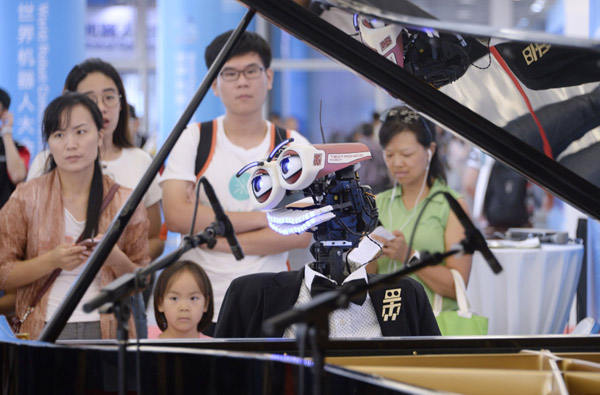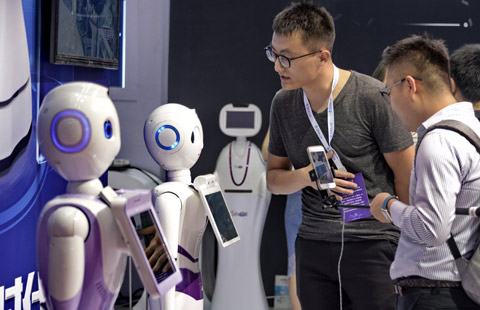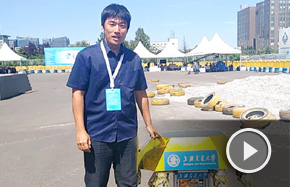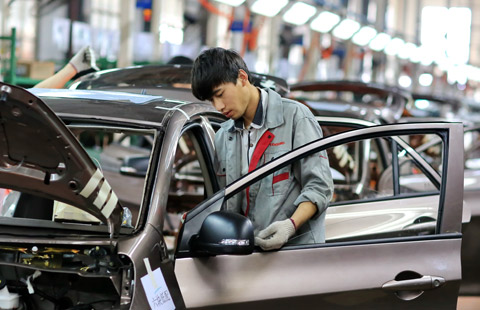Can robots replace humans in the art world?
 |
|
Visitors watch a robot play piano at the 2017 World Robot Conference in Beijing, Aug 24, 2017. [Photo/Xinhua] |
BEIJING — While few people would associate inanimate objects such robots with having artistic capabilities, the ongoing 2017 World Robot Conference in Beijing is shedding light on their creative abilities.
Dressed in a suit and tie, TeoTronico sits in front of a piano center stage in an exhibition hall, moving its fingers with great accuracy and speed to play a piece from Mozart.
Unlike a human pianist, TeoTronico has 53 "fingers." It is a purpose built pianist robot, created in Italy.
After participating in many concerts, TeoTronico has gained recognition worldwide. It has even faced off with a human pianist in a musical battle.
In addition to playing piano, it can talk, sing and make amusing facial expressions, interact in conversations, and move its head, mouth, eyes, eyelids and eyebrows.
"The robot serves as a musical education assistant, giving some insight for music learners," said Peter Chang, China representative for TeoTronico, who added that they currently don't plan to mass produce the robot pianist.
Chang said the robot performing at the conference is the third generation. The fourth generation, which has the ability to spontaneously compose music, is available in Europe.
"We don't think that robots will replace humans. This robot is intended to cooperate with its human counterparts," he said.
While TeoTronico is busy at displaying its musical talent, Saidaqian is staging an exhibition of its paintings in another area of the conference.
Wearing a peaked cap and glasses, and sporting a handlebar mustache, the 1.55-meter tall artist robot stands in silence, fully devoting to sketching portraits of visitors in black ink.
Saidaqian was created by Shenzhen Academy of Robotics. A user's photo can be sent to the robot's system, it will then begin to draw the portrait, taking around five minutes to complete it.
According to Fang Siwen from the academy, Saidaqian's appearance was designed to resemble the stereotype of foreign street artists. The robot can be used in museums, shopping malls and restaurants to teach drawing or attract customers.
The company has already sold two portrait robots prior to the conference, at a price of around 300,000 yuan ($45,000) each. Customers can also rent a robot for nearly 8,000 yuan per month, said Fang.
If a robot pianist and artist fail to amaze you, how about a robotic arm capable of writing traditional Chinese calligraphy? At a time when humans are slowly forgetting how to write by hand, robots are willing and able to do the job and do it precisely.
A robotic arm called Dobot Magician paints a Chinese couplet with a brush pen and ink, attracting many onlookers. The arm is already well-known in China after its appearance on this year's Spring Festival Gala online broadcast.
However, Dobot Magician's main function is not writing characters, said Xiang Haibing, regional manager of Shenzhen Yuejiang Technology, the robotic arm's creator. "It can also be used in other fields such as 3D printing and laser engraving."
Xiang said that the company has sold more than 5,000 similar robotic arms worldwide. Most of them were purchased by educational institutes to inspire students to be more innovative.
He admitted that anything is possible in the world of robots. In the future, perhaps robots will have self-learning abilities, have their own memories or even ideas.
"So we will have higher demands on artists," Xiang said.
However, human artists are not worried about losing their place to robots.
"Robots cannot replace humans in the arts," said Chen Zhe, a Chinese composer. "The interpretation and creation of music is basically the expression of feelings."
Chen said robots can increase public interest in learning music, but they cannot effectively teach music. As they are based on programmed procedures, they cannot adjust their teaching approach according to students' learning speeds and personal feelings.
"Robots don't have creativity," said Qiu Zhijie, president of the School of Experimental Art at China Central Academy of Fine Arts.
When an artist sees beautiful scenery, he may immediately make a sketch, paint an artwork 20 years later, or just write a poem about what he saw.
"When we see his work, we can recall his experience and be moved by his feelings. The same painting produced by a robot would not touch our heart in the same way," Qiu said.
Qiu is not worried about robots stealing jobs from artists. He said the emergence of photography brought about modern paintings and several of the great painters, for example Vincent Van Gogh.
Jia Xiaoning, a Chinese painter, was interested in the artist robot Saidaqian. After appreciating its work, he said: "The biggest difference between humans and robots is that we have life and emotions."
"Different feelings push people into different states, which will affect what they see, hear and think, and eventually these feelings are shown in their paintings in terms of color and drawing strength," Jia said.
Can an artist's hand be replaced by a robot's touch? "Let's wait and see," Jia said.

























